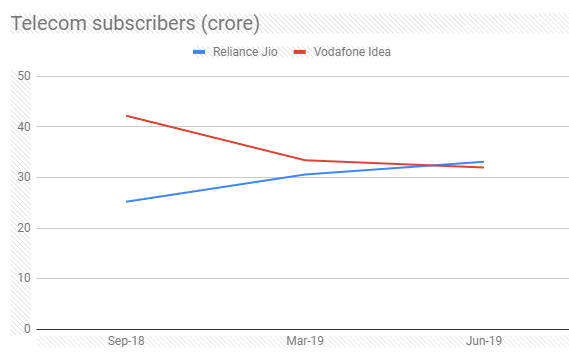Less than three years after it was launched, Jio’s disruption of India’s telecom sector is finally complete.
Reliance Jio is now India’s largest telecom player by the number of subscribers. As of June 2019, Jio has 33.1 crore subscribers, edging ahead of Vodafone Idea, which had 32 crore subscribers. Jio’s subscriber growth over the last two quarters has been stellar — in September 2018, it had 25.2 crore subscribers, which grew to 30.6 crore by March. This growth is in part coming through its competitors, who are rapidly losing users — Vodafone Idea, which had 42.2 crore subscribers in September 2018, fell to 33.4 crore in March 2019, and to 32 crore in June.

This appears to be the culmination of the plan that Mukesh Ambani had been set in motion during Reliance’s Annual General meeting in September 2016. Back then, Ambani had taken the stage and announced the launch of Reliance Jio, detailing out his pricing plans and vision. The telecom sector had immediately sat up and taken notice — during his 45 minute speech, Airtel and Idea had lost 13,800 crore in market value. But as Jio began rolling out with its free plans, there had been concerns raised about its ability to make money from its service. Experts had wondered if its users would stick around when it started charging for its plans, and whether they’d still use Jio as much as they had been when it was free.
Three years on, those fears appear to have been put to rest. At this point, Jio makes more money from its users than its rivals — Jio’s Average Revenue per User now stands at Rs. 122, while the number for Vodafone Idea is Rs. 108. Jio’s overall revenues, too, have surpassed Vodafone Idea’s, with Jio making Rs. 11,629 crore in the first quarter of FY20 compared to Rs. 11,270 made by Vodafone Idea. And to top it all, Jio is profitable – while Vodafone Idea reported losses of Rs. 4874 crore last quarter, Reliance Jio made a profit of Rs. 891 crore.
Ambani had always been bullish on Jio, talking about how it would change the entire telecom sector in India, but it would appear that Jio has done better than even he would have dared to expect. Jio is now not only India’s largest telecom player, but it’s also making Reliance money. And Jio has given Reliance a 33-crore-strong userbase to cross pitch its other services too — there have been hints that Reliance will use Jio’s offline network of stores for its much-awaited e-commerce offering, and Jio can also serve as a springboard for Reliance’s other launches, such as that of Jio GigaFiber. More importantly, Jio has transformed how Indians access the internet — cheaper data rates and the ubiquity of smartphones have helped create several industries in India, such as offline payments, and helped grow others, such as online streaming. It isn’t very often that a new business manages to displace all incumbents, make its promoter money, and transform an entire industry — Reliance Jio has done all three, and in three short years to boot.
